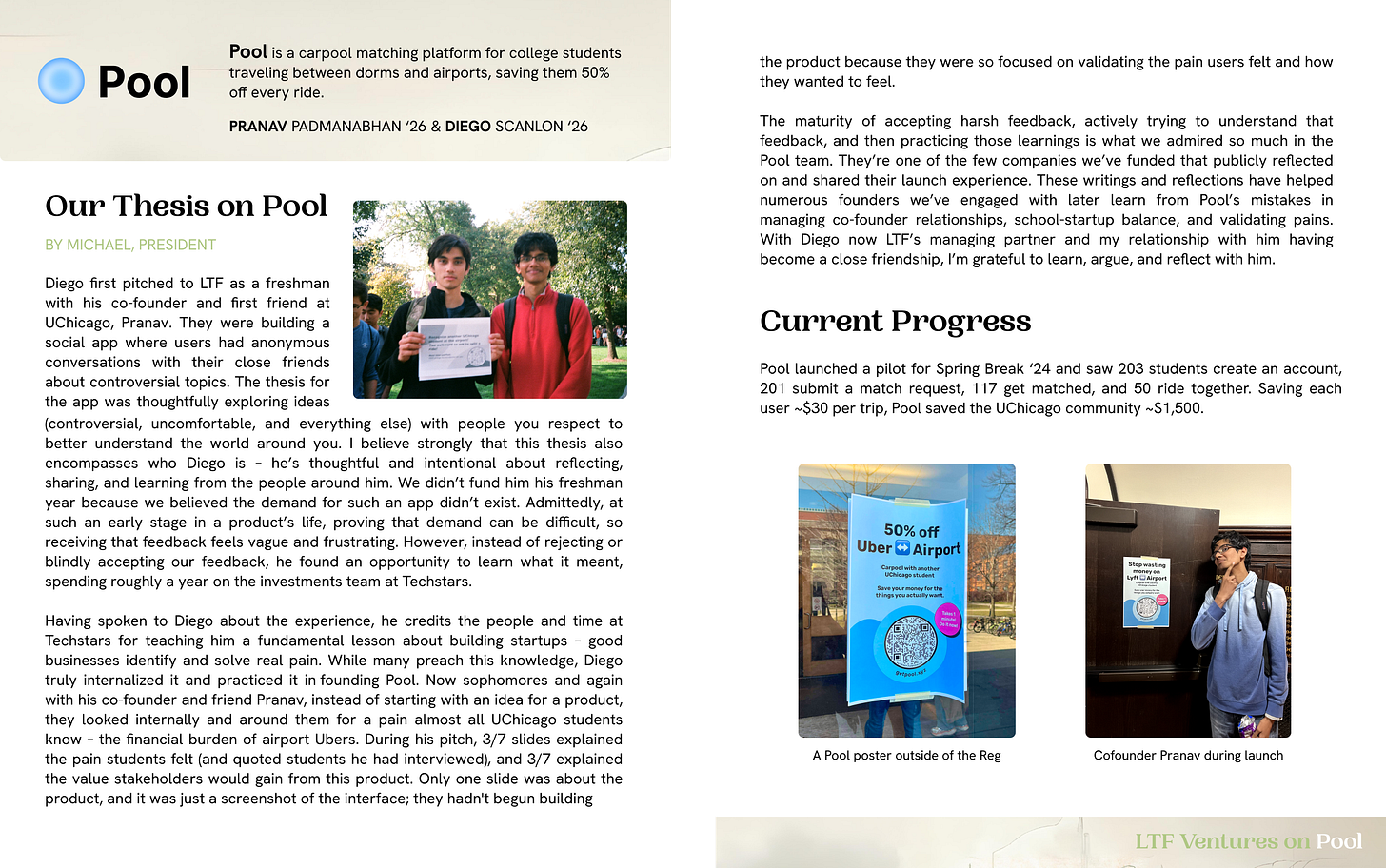The Why
Stories and relationships behind LTF's investments
Last spring, I concluded that LTF (UChicago’s student-run venture capital fund) should evaluate investment decisions primarily through founder profiles, considering traditional metrics like industry, problem, or product secondary. The belief behind this conclusion is that no founder or idea we see will have perfect practices, but some founders will be more receptive to feedback and more proactive in implementing learnings. With limited time constraining the LTF team from providing support for every deal we see, we want to help those most promising and receptive.
While the entire thought process can be read here, you don't have to read it to continue. I bring up this conclusion to share and contextualize a new LTF practice that aligns with our new thesis.
In the past, when LTF wrote its annual report (before we had the aforementioned thesis), we’d write profile pages for the individual companies we invested in that year. The page’s content would consist of a problem/solution summary, a team overview, how LTF’s investment would be used, and a progress update. This year, we started writing our annual report using this template.
However, while reviewing our team’s work, I found that the content and format felt deeply impersonal and unaligned with our new investment thesis. When we made investment decisions, we prioritized who the founding team was; coming second was what the company did or how they would use our money. Thus, we were writing about things (and presenting them as though they mattered) that came second, which felt disingenuous. Even when we wrote about our thoughts on the founding team, the style was that of a Wikipedia entry, not of our personal relationships with these founders. I’ll use Pool (my startup) as an example of how the template would be applied:
Pool was founded by Diego Scanlon and Pranav Padmanabhan, both in the class of 2026 majoring in Econ and Math respectively. Diego serves as the CEO of Pool and has previously interned at Techstars Chicago & San Francisco. Pranav is the CTO of Pool and is proficient in multiple coding languages.
It’s basic information on the founders; it doesn’t tell you much about why the LTF believed in us. Some reasons for conviction might be deduced, like how Techstars probably helped me understand how to build startups a bit better. But there’s a story behind LTF’s backing of me and Pranav, particularly one that encompasses our character and how we fit into LTF’s thesis on learning. Yet, that story is omitted — how we were best friends who met on the first day of school, how we came to LTF our freshman year with a different idea, how they told us to validate the pain more, how the second time around we hadn’t even started building our new product because we were so focused on validating the pain.
Realizing this, I suggested to Michael (LTF’s president at the time) that we change how these company pages are written — focusing less on Wikipedia language and information and more on sharing our story/relationship with the founder. He liked it and had everyone rewrite what they had already written — I was afraid people would be hesitant and resenting to do so, especially considering this ask was coming in the final weeks of our summer vacation. But, I was proud of how quickly everyone accepted and implemented the feedback and even more proud of how the new profiles came out.
Below are the two profiles I wrote for the annual report, which were the examples I presented to Michael when making the case to switch to this new format. I hope these stories are more engaging (since they’re stories), more authentic to our investment thesis, and show how much we appreciate our relationship with founders. I also added Michael’s profile on me and Pranav.





